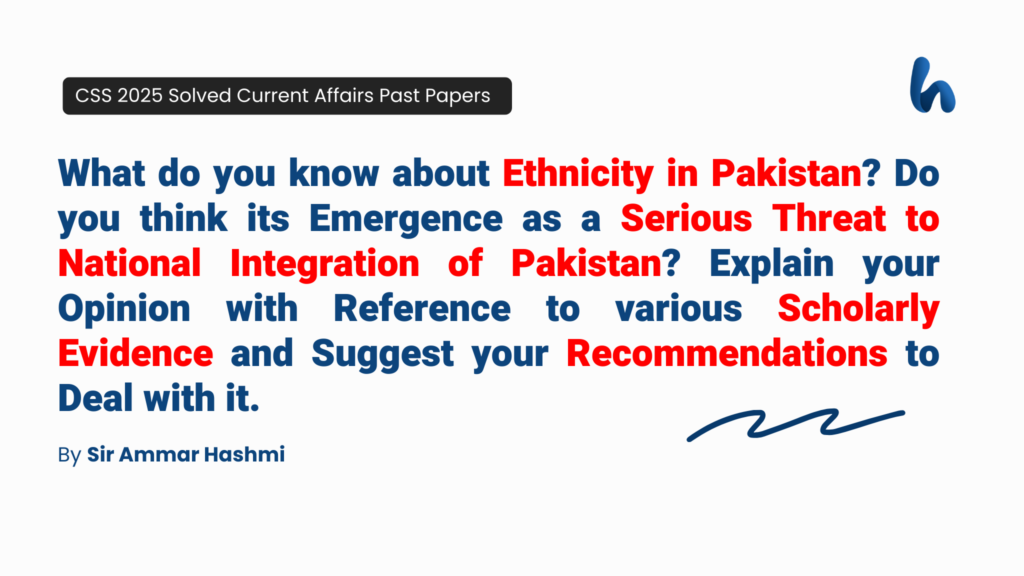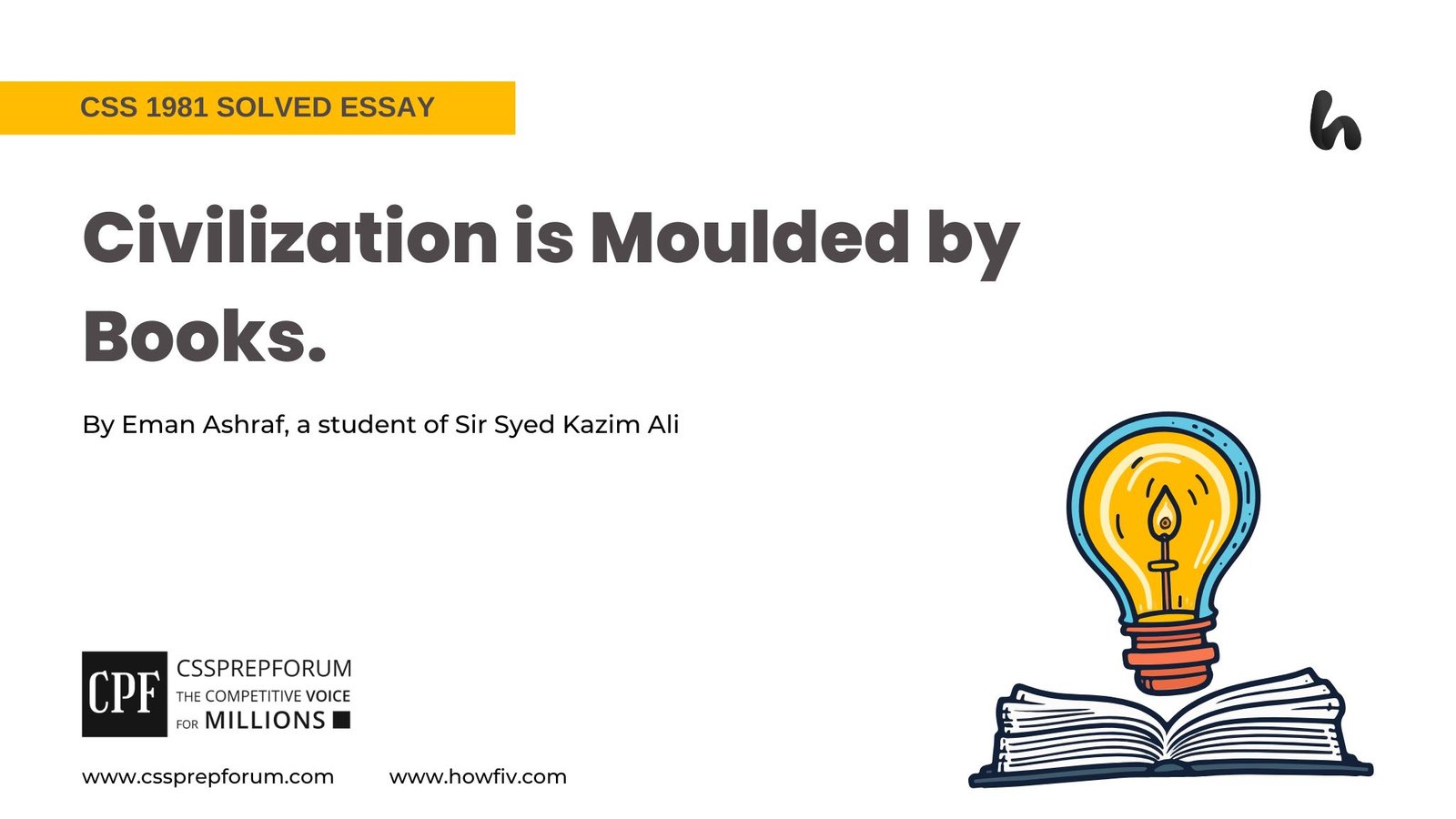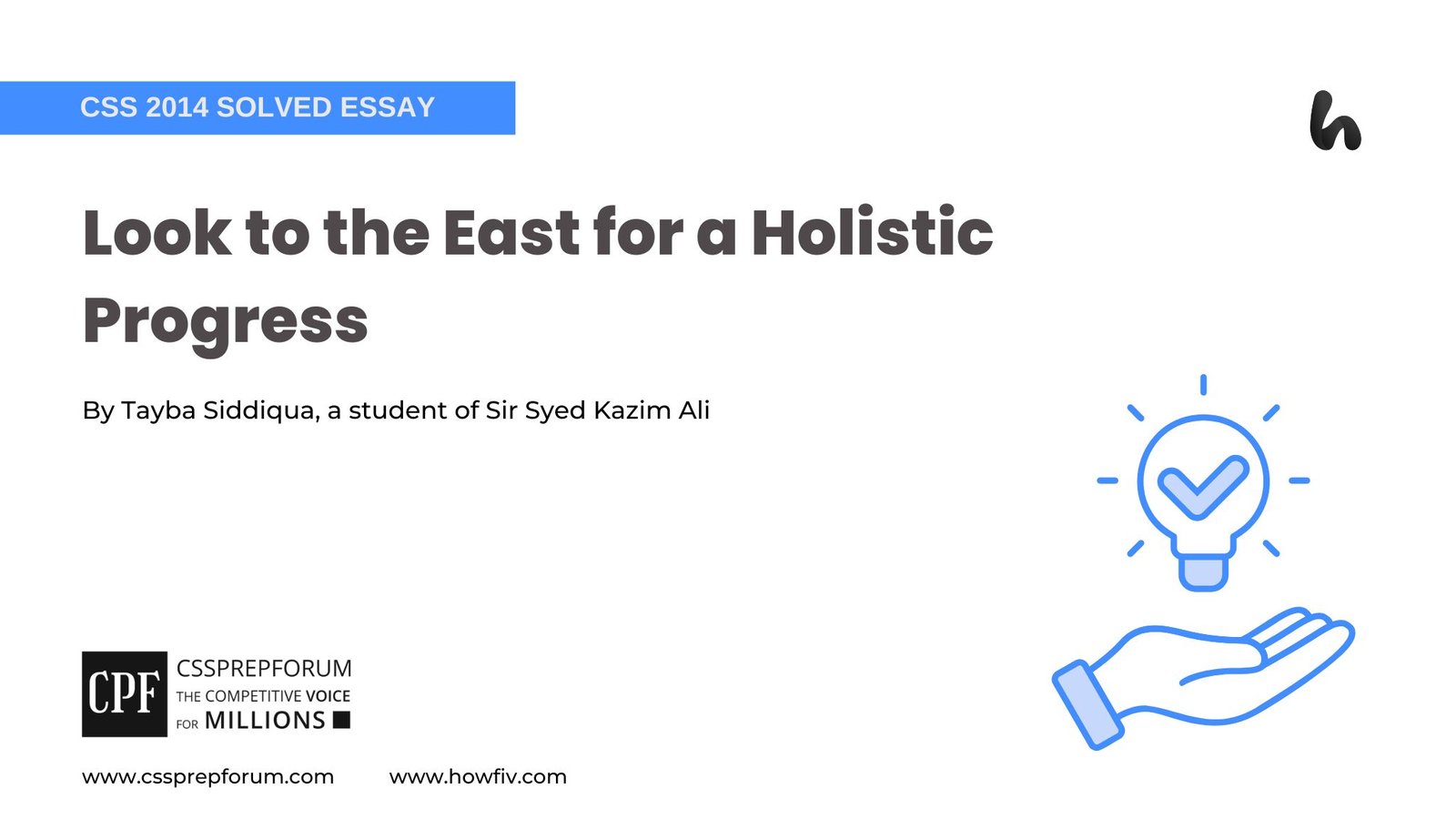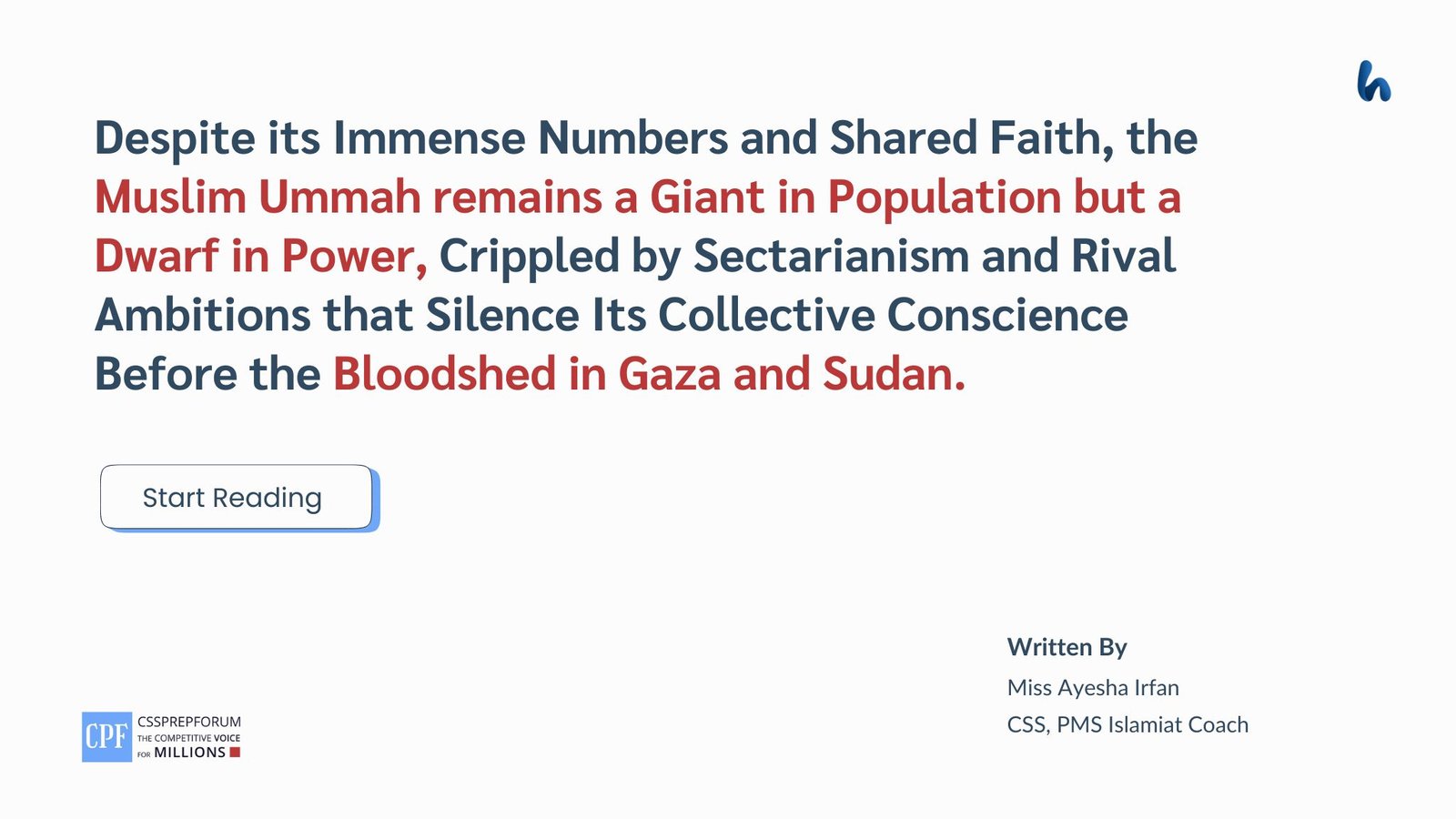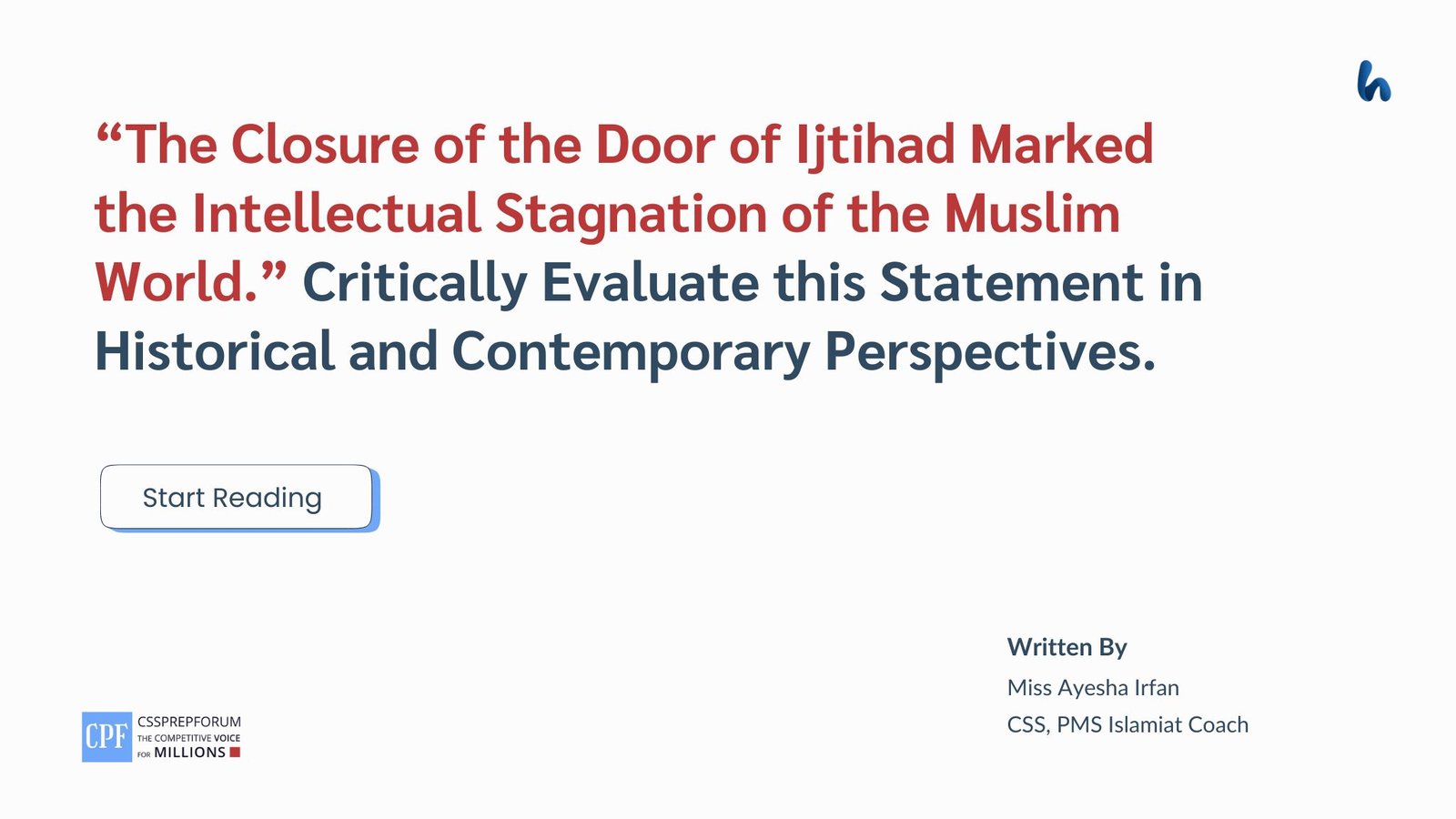CSS 2025 Solved Current Affairs Past Papers | Ethnicity in Pakistan as a Serious Threat to National Integration
The following question of CSS Current Affairs 2025 is solved by Sir Ammar Hashmi, the best Current Affairs Coach, on the guided pattern of Sir Syed Kazim Ali, which he taught to his students, scoring the highest marks in compulsory subjects for years. This solved past paper question is uploaded to help aspirants understand how to crack a topic or question, how to write relevantly, what coherence is, and how to include and connect ideas, opinions, and suggestions to score the maximum.

Question Breakdown
In this question, the examiner has asked you two following things: first, what do you know about ethnicity in Pakistan; second, do you think its emergence as a threat to national integration, and last, suggestions to tackle it. You have explicitly asked to support your opinion with reference to scholarly evidence. So, start with describing the current state of ethnic issues in the country. Then, take your stance and support it with evidence. Last, suggest measures to strengthen national integration.
Outline
1-Introduction
2-Current State of Pakistan’s Ethnic Dilemma, a Struggle for Power and Recognition
3-Ethnic Diversity and Ethnic Rivalry in Pakistan, the Two Faces of Same Coin
4-How Punjab vs. Other Province Controversy Regulated Ethnic Rivalry Pose a Threat to National Integration?
- ✓ Punjabization, A Dominating Province over Other Federating Units
- Evidence: Farzana Sheikh, the writer of the book Making Sense of Pakistan, said that the centralized control of Punjab, especially in military and bureaucracy, has contributed to the top-down national narrative of its domination, which sidelined the regional identities within the state.
- ✓ Baluch Nationalism, Ethnic Politics and A Quest For Equitable Distribution of Resources
- Evidence: Shah Mahmood Qureshi writes in the book The Baloch Nationalist Movement and the State of Pakistan that Baluch has felt sidelined, especially in the decision-making cadre, by the central government and viewed their cultural identity as under threat from the centralizing policies of the state.
- ✓ Sindh Nationalism, Ethnic Politics and A Quest For Equitable Distribution of Resources
- Evidence: In his letters to the United Nations, G. M. Syed, the proponent of modern Baluch nationalism, referred to Sindhis as a colonized nation while criticizing the post-partition power structure, which marginalized their political and economic rights.
- ✓ Pashtun Nationalism, Ethnic Politics and A Quest for Equitable Distribution of Resources
- Evidence: Riaz Mohammad writes in the book Afghanistan-Pakistan Relations: History and Geopolitics in Regional and International Perspectives that the Durand line is the root of the Pashtun-Nationalist issue and the Afghan government supports the idea of Pashtunistan.
5-Strengthening National Integration, A Pragmatic Way Forward to the Issues
- ✓ By Implementing Decentralization
- ✓ By Promoting Equitable Distribution of Resources
- ✓ By Strengthening the Rule of Law and Resolving Disputes
- ✓ By Curtailing the Politics of Patronage
6-Conclusion

Answer to the question
Introduction
Pakistan has a rich cultural tapestry, characterizing the presence of many ethno-linguistic units. The four provinces of the country are home to four leading ethnic communities, namely Punjabis, Pashtuns, Sindhis, and Baluchs. However, the smaller groups include Brahuis, Shina, Baltis, Burusho, Hazaras, Koshitanis, Uzbeks, Thari, Kahmiris, Paharis, Chitralis, Kalash, Pamiris, Nuristanis, and many more. Not ethnic diversity but ethnic rivalry poses a threat to national integration because, in its acute form, it gave birth to separatist tendencies, promoting anti-state narratives. The factors that influence the nationalist movements in the country involve two major aspects: first, the demand for provincial autonomy and equitable distribution of resources, and second, the quest to secure a dominating power at the state level. These separatist movements affect national integration in an unprecedented way, posing a threat to the country’s sovereignty. So, it is high time to deal with it by giving the provinces their legitimate share of power, promoting equitable distribution of resources, strengthening the rule of law, and curtailing politics of patronage to have checks on the use of arbitrary powers. To conclude, a National Plan of Action (NAP) is indispensable to suppress the elements that trigger parochial sentiments, promoting balkanization in the country. In addition, the state can devise a pragmatic framework to promote national integration, such as national reconciliation.

Current State of Pakistan’s Ethnic Dilemma, a Struggle for Power and Recognition
In the current scenario, the country has experienced a surge in nationalist sentiments, highlighting challenges toward national integration. The Baluch separatists and various Sindhi separatists are explicitly involved in militant attacks, targeting civilians and soldiers. For example, the Baluch Liberation Army (BLA) is not only engaged in conducting militant operations but also in brainwashing the young generation and promoting anti-state narratives. Similarly, the Sindhudesh have conducted attacks on the Chinese working in Karachi. The state conducts military operations against the militants. As a result, the Baluch people, under the leadership of Mahrang Baluch, protested against state involvement in enforced disappearances, which is also a strategy of the militant groups to strengthen the anti-state narrative. Besides, the Pashtun separatist’s militant wing is also involved in spreading terror among locals to pressure the state, such as Tehrik-i-Taliban Pakistan (TTP). Besides, the leading reason for Pak-Afghan border clashes is the country’s claim that the terrorist groups use Afghan soil as a haven to take refuge and design new ant-state strategies.
Ethnic Diversity and Ethnic Rivalry in Pakistan, the Two Faces of Same Coin
Generally, cultural diversity helps people understand dispute resolution and the essence of collective development despite differences. However, in the case of Pakistan, it becomes the reason for social stratification because ethnically diverse units are in the quest for socio-economic and political domination. As a result, it reduces the social nexus between them, posing a threat to the country’s sovereignty. The state has a rich cultural tapestry, portraying different shades of human organization in various forms. It is home to diverse ethno-linguistic communities, such as Punjabi, Pashtuns, Sindhi, and Muhajir, the leading ethnic groups. Adding more, the smaller groups include Brahui, Shina, Balti, Burusho, Hazara, Makrani, Kohistani, Uzbeks, Thari, Tajik, Kahmiri, Pahari, Chitralis, Torwali, Kalash, Pamiri, Nuristani, and Siddi. Among them, the Muslim groups have elements of shared culture because of religious proximity. However, these culturally diverse communities possess a unique feature of an uncompromising stance on their ethnic identity. Their non-negotiable standing makes problems only when their individual interests supersede the collective interests of the nation. It is the point where ethnic diversity morphs into ethnic rivalry when one ethnic unit seeks to strengthen its socio-economic and political standing at the expense of the other dominating in the socio-economic and political sphere over the other. Thus, instead of developing provincial standing as diverse units of one nation, they are more known as separatist tendencies in a federal state, characterizing balkanization. The following points describe how ethnic rivalry, not ethnic diversity, poses a threat to national integration.
How Punjab vs. Other Province Controversy Regulated Ethnic Rivalry Pose a Threat to National Integration?
- ✓ Punjabization, A Dominating Province over Other Federating Units
First, Punjab, the country’s most populous province, dominates over other federating units not only in the decision-making cadre but also in society. Its dominance affects the socio-political and economic standing of smaller provinces in an unprecedented way, which provokes resentment among smaller provinces. For illustration, Farzana Sheikh, the writer of the book Making Sense of Pakistan, said that the centralized control of Punjab, especially in military and bureaucracy, has contributed to the top-down national narrative of its domination, which sidelined the regional identities within the state. The dominating aspect of Punjabis in the socio-economic and political sphere derives from two sources: first, the inherent legacy, and second, its capable and developed population. In terms of politics, an inherent post-colonial power and, in a current scenario, the privilege of being a majority in a democratic Pakistan. Indubitably, the politico-economic standing of the province over other provinces can be described by an inherent legacy of power and standing in the leading decision-making institutions, such as the military and civil service. However, the issue is contingent on its continuance in the present, when the world is heading toward more pragmatic forms of governance and working models that ensure fair distribution of resources. Besides, it’s a fact that the province is more developed in terms of human resources, so maybe it has better choices of capable workforce for recruitment in the leading areas. However, it is the state’s responsibility to ensure equitable development that promotes inclusivity and obstructs resentment of smaller units.
- ✓ Baluch Nationalism, Ethnic Politics and A Quest For Equitable Distribution of Resources
Second, the Baluch ethnic rivalry, widely known as Baluch nationalism and Baluch Insurgency, poses a threat to national integration, which stems from two factors: first, Baluch identity-based political aspirations of dominating in state politics, and second, lack of access to resources. Regarding political demands, the Baluch nationalists seldom represent Baluch grievances, and others have their power-dominance agendas. For illustration, Shah Mahmood Qureshi writes in the book The Baloch Nationalist Movement and the State of Pakistan that Baluch has felt sidelined, especially in the decision-making cadre, by the central government and viewed their cultural identity as under threat from the centralizing policies of the state. It is not a mere demand of political representation to represent the rights of native people, which is a legitimate right of the Baluch people, but a feudal echo to have a clear standing in politics. Regarding the issue of resources, nationalism represents the collective demand for equal distribution of resources. For example, the gas reserves of Sui (Baluchistan) have been a source of energy for the state. Still, the native people lack access as the central government exploits resources, and profit sharing is inequitable. Balochis are less developed than Punjabis in terms of living standards and education. The issues start when nationalism morphs into separatism and insurgency, which not only pose a significant threat to internal stability but also to external stability because external opportunist forces, such as India, use these separatist elements to destabilize the country. For example, the Baluch Liberation Army (BLA), a separatist militant group, has intensified its attacks in the province, and India is accused of facilitating the movement.
- ✓ Sindhi Nationalism, Ethnic Politics and A Quest For Equitable Distribution of Resources
Third, Sindhi nationalism or ethnic rivalry, demands more provincial autonomy and sometimes complete separatism. Likewise, Baluchistan also poses a threat to national integration as it plays a vital role in strengthening parochial feelings among Sindhis. The reasons include the political and economic marginalization of Sindhi due to the dominance of Punjab, the urban-rural divide-led uneven development (Muhajirs vs Sindhis), and partly the urge for political domination. The latter represents the agenda of separatists as they demand the creation of an independent state, which may be referred to as Sindhudesh. G. M. Syed is considered the proponent of modern Sindhi nationalism, who founded Jaey Sindh Mahaz in 1972 after the separation of East Pakistan. For illustration, in the letters to the United Nations, G. M. Syed referred to Sindhis as a colonized nation while criticizing the post-partition power structure, which marginalized their political and economic rights. Besides, the province contributes to the economy through its natural resources, such as oil, gas, and coal, but does not get proportional benefits, and non-Sindhis (Muhajirs) control its economy. It sparked parochial feelings and a quest for the perseverance of their economic rights. Notably, Sindhi nationalism demanding more provincial autonomy is not an issue, but problems arise when they refer to complete segregation as the only option for their problems.
- ✓ Pashtun Nationalism, Ethnic Politics and A Quest for Equitable Distribution of Resources
Last, Pashtun nationalism, whose proponents and supporters have an option for accession, is inspired by the idea of Pashtunistan. For illustration, Riaz Mohammad writes in the book Afghanistan-Pakistan Relations: History and Geopolitics in Regional and International Perspectives that the Durand line is the root of the Pashtun-Nationalist issue and the Afghan government supports the idea of Pashtunistan. Pashtuns are the second largest ethnic group after Punjabis and remained counterparts of Punjabis in history. However, they argue that Punjabi’s domination in politics, economy, and military affairs sidelined their rights. Then, the military crackdowns to suppress the uprising further ignited resentment among Pashtun groups. The former state policies, especially state-trained Jihadi credentials during the Soviet occupation of Afghanistan and the US-led War on Terror in their acute and extremist forms, promote anti-state sentiments when the state does not support their pan-Islamist agenda. Moreover, the movement poses a threat to national unity.
Strengthening National Integration, A Pragmatic Way Forward to the Issues
The following point provides a pragmatic way forward to strengthen the essence of national integration among the federating units.
- ✓ By Implementing Decentralization
First, unique problems need unique solutions because no conflict-resolution model can fit into the country’s societal structure. Regarding the reasons for the lack of national integration, two factors influence parochial sentiments and trigger nationalist feelings, so targeting these factors can help mitigate the issue. The state addresses the long-standing provincial demand for autonomy in the historic 18th Amendment in the Constitution of 1973, but loopholes in its implementation aggravate parochial sentiments. For example, the irregularities in the commencement of the National Finance Commission Award (NFC), which is responsible for the distribution of resources, create hurdles in implementing the framework designed to promote national integration. So, the state must prioritize its implementation in the true sense. At this time, a pragmatic framework for implementation of the 18th Amendment is the need of the hour because, at this time, this is a mere step, and its true potential relies on its execution.
- ✓ By Promoting Equitable Distribution of Resources
Second, the equitable distribution of resources must be prioritized, but it is not only solely reliant on the execution of the NFC Award. It is contingent on conflict resolution, so strengthening the Council of Common Interest (CCI) is the need of the hour. After gaining strength in the effective distribution of financial resources and dispute resolution, the next step can be capacity-building because traditional methods can’t fit into the new governance models, especially technological integration. The uneven development causes a lack of competency in the rural areas of Sindh, Baluchistan, and KPK, so capacity-building is the key to unlocking the full potential of decentralization because after getting a reasonable fiscal share, if the provincial leadership fails to address the issues of its respective population, then the state will be declared responsible.
- ✓ By Strengthening the Rule of Law and Resolving Disputes
Third, promoting the rule of law is indispensable to strengthening national integration because acute ethnic nationalists can take advantage of decentralization. Notably, federalism best works when federating units are bound with each other, showcasing the essence of national integration. So, the supremacy of law restricts the federating units from exercising extrajudicial powers. Then, it also promotes equality among all the units. It is imperative to note that supremacy of law requires the acknowledgement of one paramount constitution under a constitutional body that represents the state, so feudal tendencies need to restrict their influence when it comes to the supremacy of the law.
- ✓ By Curtailing the Politics of Patronage
Last, the politics of patronage needs to be tackled because it is the leading cause of exercising unrestricted power by few. So, if these few have separatist tendencies, then promoting anti-state narratives becomes accessible because of the state-provided patronage. Notably, the political system works on patronage-based links, so the state is also bound to offer patronage to continue the mandate. The nexus of political parties from the top to the grassroots level gives uncontrolled power to many people as they buy allegiances and offer patronage in return. So, cooperation and co-existence can strengthen a nation instead of providing patronage. To curtail the patronage-based political system, democratic elections at the federal and provincial levels can prove a significant option.
Conclusion
To conclude, a National Plan of Action (NAP) is indispensable to suppress the elements that trigger parochial sentiments, promoting balkanization in the country. In addition, the state can devise a pragmatic framework to promote national integration, such as national reconciliation. The four provinces of the country are home to four leading ethnic communities, namely Punjabis, Pashtuns, Sindhis, and Baluchs. Not ethnic diversity but ethnic rivalry poses a threat to national integration because, in its acute form, it gave birth to separatist tendencies, promoting anti-state narratives. The factors that influence the nationalist movements in the country involve two factors: first, the demand for provincial autonomy and equitable distribution of resources, and second, the quest to secure a dominating power at the state level. These separatist movements affect national integration in an unprecedented way, posing a threat to the country’s sovereignty. So, it is high time to deal with it by giving the provinces their legitimate share of power, promoting equitable distribution of resources, strengthening the rule of law, and curtailing politics of patronage to have checks on the use of arbitrary powers.

CSS Solved Past Papers’ Essays
Looking for the last ten years of CSS and PMS Solved Essays and want to know how Sir Kazim’s students write and score the highest marks in the essays’ papers? Then, click on the CSS Solved Essays to start reading them.
CSS Solved Essays
CSS Solved General Science & Ability Past Papers
Want to read the last ten years’ General Science & Ability Solved Past Papers to learn how to attempt them and to score high? Let’s click on the link below to read them all freely. All past papers have been solved by Pakistan’s top CSS GSA coach having the highest score of their students.
General Science & Ability Solved Past Papers

